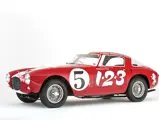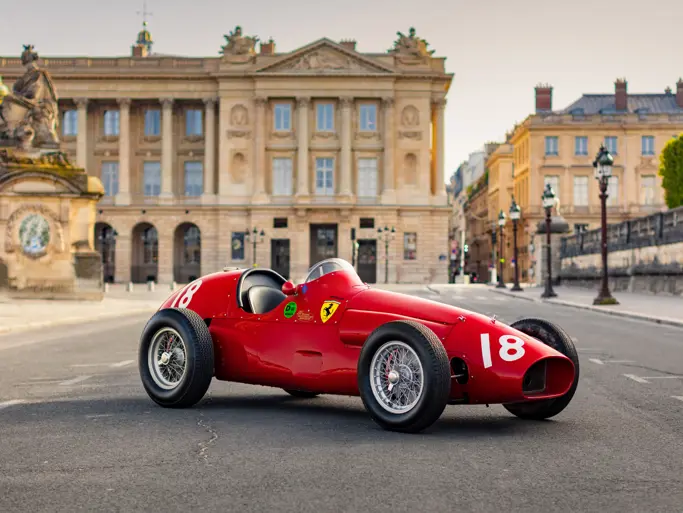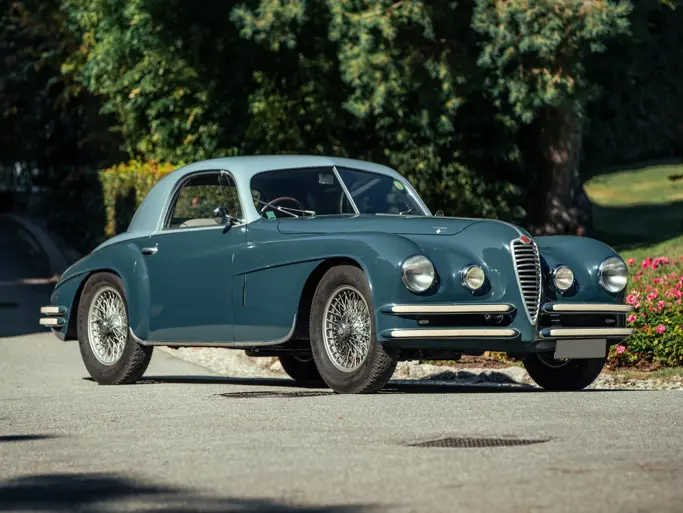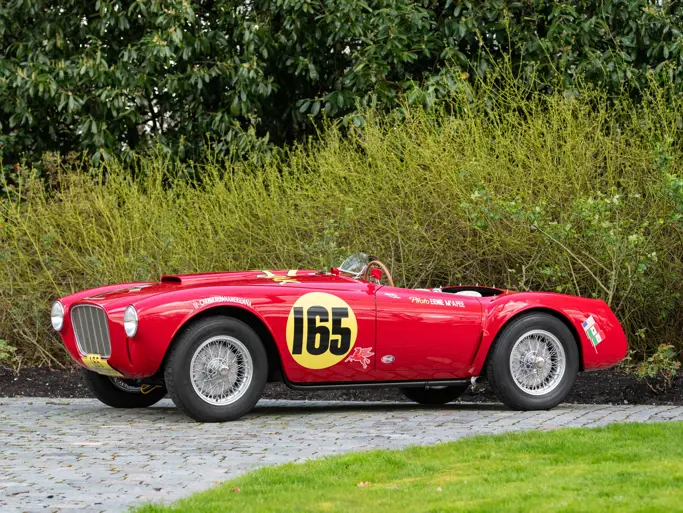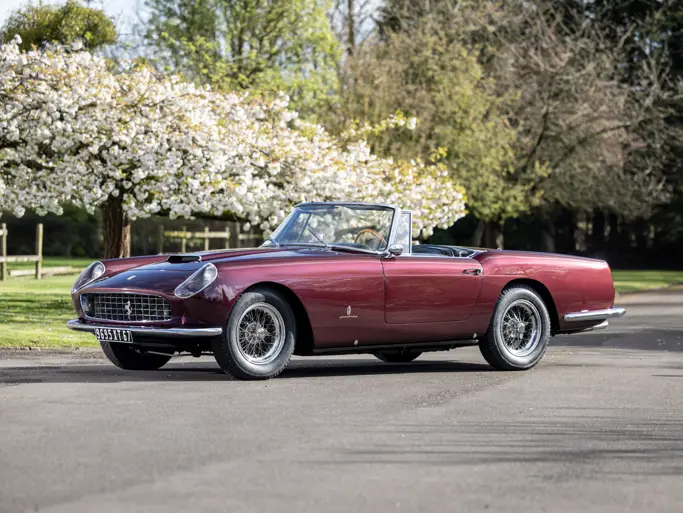Villa d'Este 2011
1953 Ferrari 250 MM Berlinetta by Pinin Farina
{{lr.item.text}}
€2,500,000 - €3,000,000 EUR | Not Sold
 | Cernobbio, Italy
| Cernobbio, Italy
{{internetCurrentBid}}
{{internetTimeLeft}}

240 hp, 2,953 cc SOHC V-12 engine, three Weber carburettors, four-speed manual transmission, independent front suspension with unequal-length A-arms and transverse leaf springs, rear live axle with semi-elliptic leaf springs and trailing arms, four-wheel hydraulic drum brakes. Wheelbase: 2,400 mm (94.5")
- An outstanding 250 MM with original engine and extraordinary history
- Successfully raced by Efrain Ruiz Echeverria in 1953 Carrera Panamericana
- Best finish by Mexican national in all five years of race
- One of only 18 250 MM PF Berlinettas built
- Hans Tanner Award for Best Ferrari on the field at Pebble Beach
- Restoration by marque specialists
The 1952 La Carrera Panamericana road race in Mexico was as dangerous as ever, the crisis-to-crisis event filled with fatal accidents, buzzards crashing through windshields and tyres shredded on the rough roads. This was not a race for the faint of heart. Although Mercedes’ Gullwing 300SL Coupés enjoyed a one-two finish, Luigi Chinetti was close behind in a Ferrari 340 Mexico, and Alberto Ascari was charging ahead in one of the two other sister cars before crashing after 90 miles.
Though the Mercedes team triumphed, the fastest car on the course was Giovanni Bracco in the Ferrari 250 MM Berlinetta prototype. He led the race from the second stage until his transmission gave out with only 300 miles to go.
Efrain Ruiz Echeverria
This fact was not lost on Efrain Ruiz Echeverria, an ambitious road racer who had privately entered a 212 Inter Berlinetta (chassis 0239 EU) for the race in 1952. He was doing very well, even finishing the second stage ahead of Phil Hill, before skidding off the road on the third stage of the 1,932-mile race while in tenth place.
Already the fastest Mexican driver, he sent his 212 s/n 0239 EU off to Italy to be repaired, then had a better idea. He contacted Modena and asked them instead to build a new 250 MM for him, just like Bracco’s car.
Import taxes could be prohibitive, especially in South America in the 1940s and ’50s, so Echeverria asked if his new 250 MM could have the same chassis number as his old 212, which enabled him to take the car back to Mexico with the identity of the 212 and avoid strong import taxes. Ferrari was used to this international difficulty and complied, particularly for a repeat customer, but Echeverria’s 250 MM chassis had already been assigned s/n 0352 MM. Since both numbers are visible on the chassis, that accounts for the dual identity of this car today.
Meanwhile, Echeverria’s original 212 Inter Berlinetta was repaired by the factory and resold as s/n 0292 in 1953.
The 1953 Carrera Panamericana
Now in possession of his brand-new Ferrari 250 MM, Echeverria attacked the ’53 race head-on, joined by riding mechanic Pedro Villegas.
Competition was fierce. Lancia had prepared a full team effort for the 1953 Carrera, sending five 3-litre roadsters for Fangio, Taruffi, Bonetto, Bracco, and Castellotti. Five Ferrari Berlinettas were provided by Italian sportsman Franco Cornacchia for Umberto Maglioli, Mario Ricci, Fabrizio Mancini, Antonio Stagnoli and Luigi Chinetti – but weren’t factory cars – while Phil Hill shared another Ferrari with fellow Californian Ritchie Ginther.
Faced with world-class opposition, Echeverria acquitted himself extremely well and finished in 7th place in the sports car class, as the top privateer and the highest ranking of a Mexican driver in the five years the race was run. Driving on number 5 – the livery in which the car is presented today – he went from 13th place at the end of the first stage to as high as 6th, ahead of Louis Rosier in the Talbot. The race was as frightening and dangerous as ever. There were only 61 finishers of 177 starters, with accidents involving anything from blown tyres, overturned cars and catastrophic fires, but Echeverria survived unscathed.
The finishing order was Fangio, Taruffi, Castellotti (all Lancia), Mancini (Ferrari), Rosier (Talbot), Maglioli and Echeverria (Ferrari).
Later History
Echeverria later sold the car to E.R. Stetson in Mexico City in 1956, who kept the car for over ten years. Another enthusiast, Andres Velarde, acquired the car in 1967.
In 1975 Ferrari expert Stan Nowak flew to Mexico City from New York to buy four racing cars from Andres Velarde. He purchased three Maseratis, an OSCA and was shown a Ferrari 250 MM, which turned out to be 0352 MM/0239 EU. He documented this extraordinary experience in an article he wrote for Cavallino in December 1979 (“To Mexico with Love”).
Nowak conducted extensive research before finally convincing Velarde to sell the car 18 months later. S/n 0352 MM/0239 EU was then subjected to a three-year frame-off restoration by Grand Prix SSR Co. in New York and found to be very original. In October 1979 it was sold to Andres Baptista in Mexico City, who already owned the 1951 212 Inter Vignale Berlinetta that was driven to 2nd place in the 1951 Carrera by Alberto Ascari. Baptista managed to track down Efrain Echeverria in Madrid and his riding mechanic in Mexico, who confirmed details of the car’s history.
Gary Bobileff then restored the car again for new owner Baptista during the early 1980s. The combination of s/n 0352 MM/0239 EU’s originality and the quality of the restoration led to a class win at Pebble Beach in 1983 and the Hans Tanner award as the best Ferrari on the field. At that time, the car was in Japanese ownership. Subsequent owners included Ron Kellogg and Mexican industrialist Lorenzo Zambrano.
Fully restored to modern concours-quality, “Pebble Beach” standards by Tillack & Company, s/n 0352 MM/0239 EU was shown at Pebble Beach in 2002. It was also shown at the International Ferrari Concours, as Ferrari was the honoured marque at the Monterey Historic races that year.
The car’s performance has been tested in competition since then, including by veteran racer Pablo Gonzales in the 2004 Monterey Historics. All told, only 31 250 MMs were built, all Pinin Farina-bodied, with the exception of a Vignale coupé and spyder. Of the Pinin Farina cars, only 18 were berlinettas, including chassis 0352 MM / 0292 EU, which is certainly one of the most fascinating examples in existence. It would be a feat in itself simply to survive the Carrera Panamericana unscathed. A seventh place finish by a privateer can only be chalked up to masterful driving and sheer daring – and the uncovering of its extraordinary history to the expertise of dogged historians. It goes without saying that this car is eligible for virtually any event the successful bidder might be interested in. What better way to slingshot down the corkscrew at Laguna Seca or fire off the starting block in Brescia?
240 cv, motore V-12 di 2.953 cc con un albero a camme in testa, tre carburatori Weber, cambio manuale a quattro marce, sospensione anteriore a ruote indipendenti con trapezi e balestra trasversale, assale posteriore rigido con balestre semi-ellittiche e puntoni di reazione, freni a tamburo idraulici. Passo: 2.400 mm (94.5")
- Un'eccezionale 250 MM con il suo motore originale e una straordinaria storia
- Guidata con successo da Efrain Ruiz Echeverria alla Carrera Panamericana del 1953
- Miglior risultato di un pilota messicano nella storia delle cinque edizioni della corsa
- Una delle sole 18 250 MM PF Berlinetta costruite
- Premio Hans Tanner per la Migliore Ferrari nel Concorso di Pebble Beach 1983
- Restaurata da specialisti della marca
La Carrera Panamericana del 1952 in Messico fu pericolosa come sempre, afflitta da eventi drammatici come incidenti mortali, poiane che sfondarono parabrezza e pneumatici disintegrati dall'asfalto ruvido. Non è mai stata una corsa per deboli di cuore. Le Mercedes 300 SL "ali di gabbiano" si classificarono al primo e secondo posto, ma la Ferrari 340 Mexico di Luigi Chinetti arrivò molto vicina e Alberto Ascari, su una delle altre due vetture gemelle, stava puntando alla testa della corsa prima di incorrere in un incidente dopo solo 90 miglia.
Sebbene le Mercedes avessero trionfato, la vettura più veloce in gara fu la Ferrari 250 MM Berlinetta prototipo di Giovanni Bracco, che guidò la corsa dalla seconda tappa fino alla rottura della trasmissione a 300 miglia dall'arrivo.
Efrain Ruiz Echeverria
Questa impresa non sfuggì a Efrain Ruiz Echeverria, un ambizioso stradista che si era iscritto all'edizione del 1952 della corsa con una 212 Inter Berlinetta privata (telaio 0239 EU). Stava facendo bene, addirittura nella seconda tappa era arrivato davanti a Phil Hill, ma poi durante la terza tappa (la corsa era lunga 1.932 miglia) era uscito di strada mentre era in decima posizione.
Era già il pilota messicano più veloce e aveva deciso di inviare la sua 212 telaio 0239 EU in Italia per la riparazione, quando ebbe un'idea migliore. Si mise in contatto con Modena e chiese che gli venisse costruita una 250 MM nuova, uguale a quella di Bracco.
I dazi all'importazione potevano essere proibitivi, specialmente in Sud America negli anni Quaranta e Cinquanta, quindi Echeverria chiese che la nuova 250 MM avesse lo stesso numero di telaio della sua vecchia 212. In Ferrari erano abituati a queste difficoltà internazionali e accondiscesero alla richiesta di un cliente abituale come Echeverria, anche se alla sua nuova 250 MM era già stato assegnato il numero di telaio 0352 MM. Entrambi i numeri sono visibili sul telaio e ciò giustifica oggi la doppia identità della vettura.
La vecchia 212 Inter Berlinetta di Echevarria, fu riparata e venduta nel 1953 come telaio 0292.
La Carrera Panamericana del 1953
Finalmente in possesso della sua Ferrari 250 MM nuova di fabbrica, Echeverria attaccò di slancio l'edizione 1953 della corsa, accompagnato dal meccanico Pedro Villegas.
Fu, come sempre, una corsa dura. La Lancia aveva preparato uno squadrone di cinque sport 3-litri per Fangio, Taruffi, Bonetto, Bracco, e Castellotti. Non c'erano Ferrari ufficiali, ma Franco Cornacchia aveva iscritto cinque Berlinette per Umberto Maglioli, Mario Ricci, Fabrizio Mancini, Antonio Stagnoli e Luigi Chinetti, mentre Phil Hill divideva un'altra Ferrari con il collega californiano Ritchie Ginther.
Opposto ad antagonisti di fama mondiale, Echeverria diede una grande prova di sé e si classificò al settimo posto nella categoria sport, primo fra i piloti privati e ottenne il miglior piazzamento di un pilota messicano nella storia delle cinque edizioni della corsa. Con il numero di gara 5, lo stesso presente oggi sulla vettura, egli scalò la classifica dal tredicesimo posto alla fine della prima tappa fino ad occupare il sesto, davanti alla Talbot di Louis Rosier. La corsa fu combattuta e pericolosa, come sempre. Dei 177 piloti partiti solo 61 giunsero al traguardo, con incidenti di ogni tipo: pneumatici esplosi, vetture capovolte, incendi catastrofici, ma Echeverria arrivò incolume.
L'ordine di arrivo fu il seguente: Fangio, Taruffi, Castellotti (tutti su Lancia), Mancini (Ferrari), Rosier (Talbot), Maglioli e Echeverria (Ferrari).
La storia successiva
Nel 1956 Echeverria vendette la vettura a E.R. Stetson di Città del Messico, che la tenne per oltre dieci anni. Un altro appassionato, Andres Velarde, la acquistò nel 1967.
Nel 1975 l'esperto di Ferrari Stan Nowak volò a Città del Messico da New York per comprare quattro vetture da corsa da Andres Velarde. Egli acquistò tre Maserati e una OSCA e gli fu mostrata una Ferrari 250 MM, la 0352 MM/0239 EU. Il documentò questa straordinaria esperienza nell'articolo "Dal Messico con Amore” pubblicato sul numero di dicembre 1979 della rivista Cavallino.
Nowak fece esaustive ricerche e finalmente, 18 mesi dopo, convinse Velarde a vendergli la vettura. La 0352 MM/0239 EU, trovata in condizioni molto originali, fu quindi sottoposta ad un restauro totale durato tre anni ed eseguito dalla Grand Prix SSR di New York. Nell'ottobre 1979 fu venduta a Andres Baptista, di Città del Messico, che già possedeva la 212 Inter Vignale Berlinetta del 1951, che Alberto Ascari aveva portato al secondo posto alla Carrera del 1951. Baptista riuscì a rintracciare Efrain Echeverria, a Madrid, e il suo meccanico in Messico, che gli confermarono alcuni particolari sulla storia della vettura.
Nei primi anni Ottanta, Gary Bobileff restaurò nuovamente la vettura per Baptista. L'unione fra l'originalità della 0352 MM/0239 EU e la qualità del restaurò portò alla vittoria di classe del premio Hans Tanner per la Migliore Ferrari a Pebble Beach nel 1983. All'epoca la vettura era di proprietà di un giapponese. Fra i successivi proprietari ci furono Ron Kellogg e l'industrale messicano Lorenzo Zambrano.
Completamente restaurata secondo i moderni concetti qualitativi di restauro e gli standard “Pebble Beach” da Tillack & Company, nel 2002 la 0352 MM/0239 EU fu esibita nuovamente a Pebble Beach e al Concorso Internazionale Ferrari, poiché in quell'anno la casa di Maranello era la marca onorata alle corse storiche di Monterey.
Sin da allora furono mostrate le prestazioni della vettura in corsa, confermate dal pilota veterano Pablo Gonzales al Monterey Historics del 2004. Ciò detto, solo 31 250 MM furono costruite, tutte con carrozzeria Pinin Farina tranne un coupé e uno spyder di Vignale. Delle Pinin Farina, 18 erano berlinette, compresa la 0352 MM / 0292 EU che è certamente uno degli esemplari più affascinanti ancora esistenti. Il semplice fatto di arrivare incolume in fondo alla Carrera Panamericana è già di per sé un risultato degno di menzione. Il settimo posto per una vettura privata depone a favore di una guida magistrale e audace, e la scoperta della sua storia straordinaria è la dimostrazione della tenacia e determinazione di storici ostinati. E' inutile dire che questa vettura è utilizzabile in tutte gli eventi storici ai quali il nuovo proprietario sia interessato. Cosa c'é di più bello che fiondarsi giù dal "cavatappi" a Laguna Seca o accendere il 12 cilindri sulla pedana di Brescia?

